Over the past century, South Africa’s gold mining industry has amassed immense wealth and global recognition, fueling the nation’s economy. . Yet, beneath the glittering surface lies a grim reality: a legacy of chronic illness, poverty, and death. The gold mining industry is built on the systematic exploitation of indigenous laborers from neighboring countries, shaped by histories of imperialism and apartheid. The industry disproportionately burdens impoverished black communities from countries like Lesotho and Mozambique, leaving devastating social and economic scars. The health crises, environmental damage, and economic disparities caused by the industry underscore the urgent need for systemic reform and accountability.
Health Crises Among Mining Communities
South Africa’s gold rush of the late nineteenth and early twentieth centuries catalyzed a booming mining industry that became central to the country’s economy. Companies relied heavily on labor conscripted from neighboring states, exploiting pre-existing poverty and limited education to attract workers. Organizations like the Native Recruiting Corporation lured men with promises of stable wages, omitting the perilous conditions they would face underground. The dangers were not limited to mining accidents. The inhalation of silica dust led to widespread silicosis, a debilitating lung disease, and tuberculosis (TB), both exacerbated by poor living and working conditions. These diseases have claimed more lives than mining accidents. Research published in the Journal of Migration and Health identified occupational lung diseases as endemic among workers from Lesotho and Mozambique.
For many families, the loss of a husband or father to mining-related diseases compounded already dire circumstances. Wives were often left to care for ill spouses or shoulder the financial burden alone. Some sons were bound by contractual obligations to take their fathers’ places in the mines. Studies confirm the disproportionate impact on migrant miners. The World Bank has criticized the neglect of these communities, noting their exploitation and lack of access to adequate healthcare or compensation.
Environmental Damage
The environmental degradation caused by gold mining compounds these challenges. Mining practices deplete natural resources and pollute local ecosystems, hindering development and amplifying inequalities between South Africa and its neighbors. Entire communities in Lesotho and Mozambique have suffered as income producers succumb to illness or death, leaving families destitute. This degradation perpetuates cycles of dependency and exploitation, leaving rural economies destabilized.
Economic Disparities and Structural Violence
The conditions these miners endured illustrate systemic injustices deeply rooted in South Africa’s colonial and apartheid histories. White workers received higher wages and safer conditions, while black laborers, often from neighboring countries, faced relentless hazards with minimal compensation. This exploitation is a form of structural violence, where broader institutions prioritize profit over human life. Despite numerous lawsuits and advocacy efforts, mining corporations have largely evaded accountability. Rural economies reliant on remittances from mining wages are destabilized, further entrenching poverty. The lack of equitable reparations underscores a broader disregard for the lives and rights of black laborers, reflecting the enduring legacy of apartheid-era inequalities. The consequences of South Africa’s mining practices extend beyond individual health crises, creating widespread public health and economic challenges in neighboring states.
The Call for Justice
The documentary Dying for Gold brings these stories to life, centering the voices of miners and their families. The film contrasts their lived experiences with the narratives of powerful mining conglomerates, exposing the human cost of South Africa’s gold wealth. By incorporating testimonies from affected families and analysis from scholars, the documentary underscores the urgent need for justice and systemic reform.
To address such systemic injustices perpetrated by South Africa’s gold mining industry, the country must implement robust legislative reforms. These reforms should aim to improve workers’ rights, enhance health and safety standards, and ensure fair compensation for affected communities. While the challenges are immense, there are signs of progress, as well as successful examples from other nations that can guide South Africa in rectifying the historical exploitation of its labor force.
In regards to legislative pathways South Africa may enact, strengthening workers’ protections, establishing a compensation fund, or formalizing environmental accountability may prove most successful. Enforcing stricter safety regulations and mandating comprehensive health screenings for miners could help mitigate the ongoing health crises. Legislation must also guarantee access to healthcare for miners and their families, particularly for those suffering from occupational diseases like silicosis and tuberculosis. A centralized compensation fund, financed by mining corporations, could provide reparations for workers and their families who have been affected by mining-related illnesses or fatalities. Transparent oversight mechanisms would ensure fair distribution of these funds. Lastly, to address the environmental damage caused by mining, South Africa could implement laws requiring mining companies to rehabilitate degraded ecosystems. Strict penalties for non-compliance would incentivize corporations to adopt sustainable practices.
South Africa has made strides toward addressing some of these issues. In 2018, a historic settlement was reached in the Nkala and Others v. Harmony Gold Mining Company Limited case, where six mining companies agreed to pay R5 billion to compensate miners suffering from silicosis and tuberculosis. This landmark decision marked a turning point in recognizing the rights of exploited laborers. Additionally, ongoing legislative discussions aim to strengthen enforcement of mining regulations under the Mineral and Petroleum Resources Development Act (MPRDA). Proposed amendments seek to prioritize community development and environmental restoration.
South Africa can draw inspiration from other countries that have successfully addressed similar issues through legislation. For instance, the U.S. passed the BLBA to compensate coal miners suffering from pneumoconiosis (black lung disease). Funded by coal companies, the program provides financial and medical benefits to miners and their families. South Africa could adapt a similar model to assist gold miners affected by silicosis and tuberculosis. In Brazil, laws mandating compensation and resettlement for communities affected by dam projects have helped mitigate social and environmental damages. South Africa could adopt similar frameworks to hold mining corporations accountable for ecosystem destruction and displaced communities.
By enacting robust legislation, South Africa has the opportunity to remedy the historical injustices of its gold mining industry. Building on recent legal successes and learning from international examples, the country can create a fairer system that prioritizes the health, well-being, and rights of miners and their families. Sustainable reforms will not only address past exploitation but also pave the way for a more equitable future.
Looking Forward
South Africa’s gold mining industry serves as a stark example of how global capitalism and historical injustice intersect to exploit vulnerable populations. The health crises, environmental damage, and economic disparities wrought by the industry demand accountability, reparations, and sustainable development. The voices of those impacted—wives caring for dying husbands, sons forced into deadly contracts, and families struggling to survive—remind us of the human cost of wealth. Their stories should challenge South Africa to address these systemic inequalities and enact meaningful change.
Featured Image Source: NPR






Comments are closed.